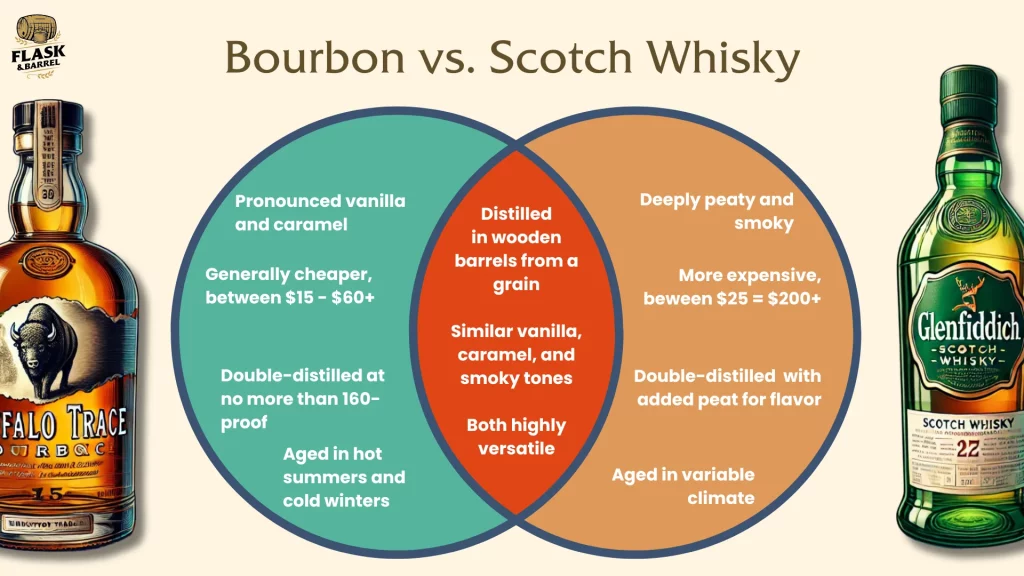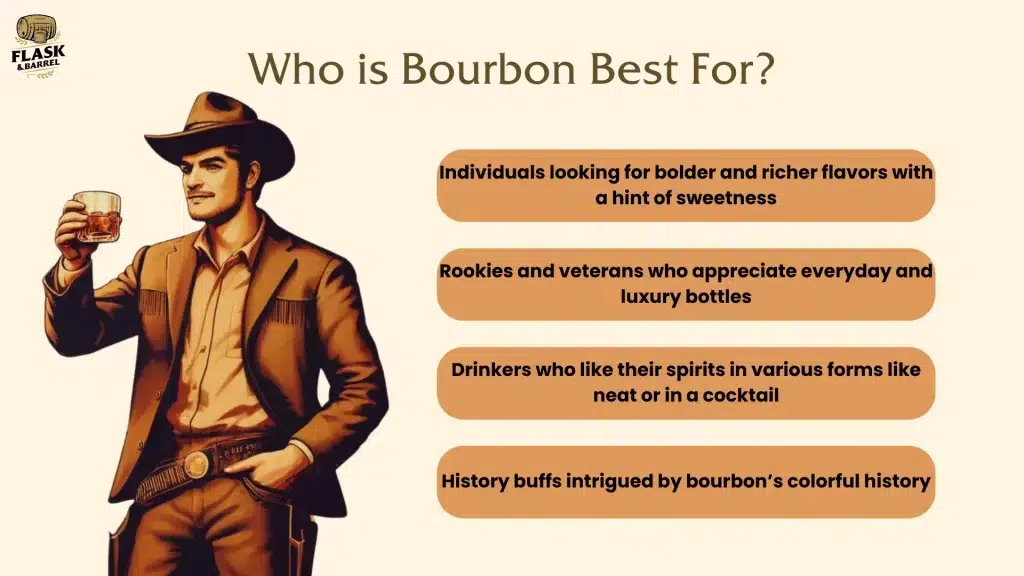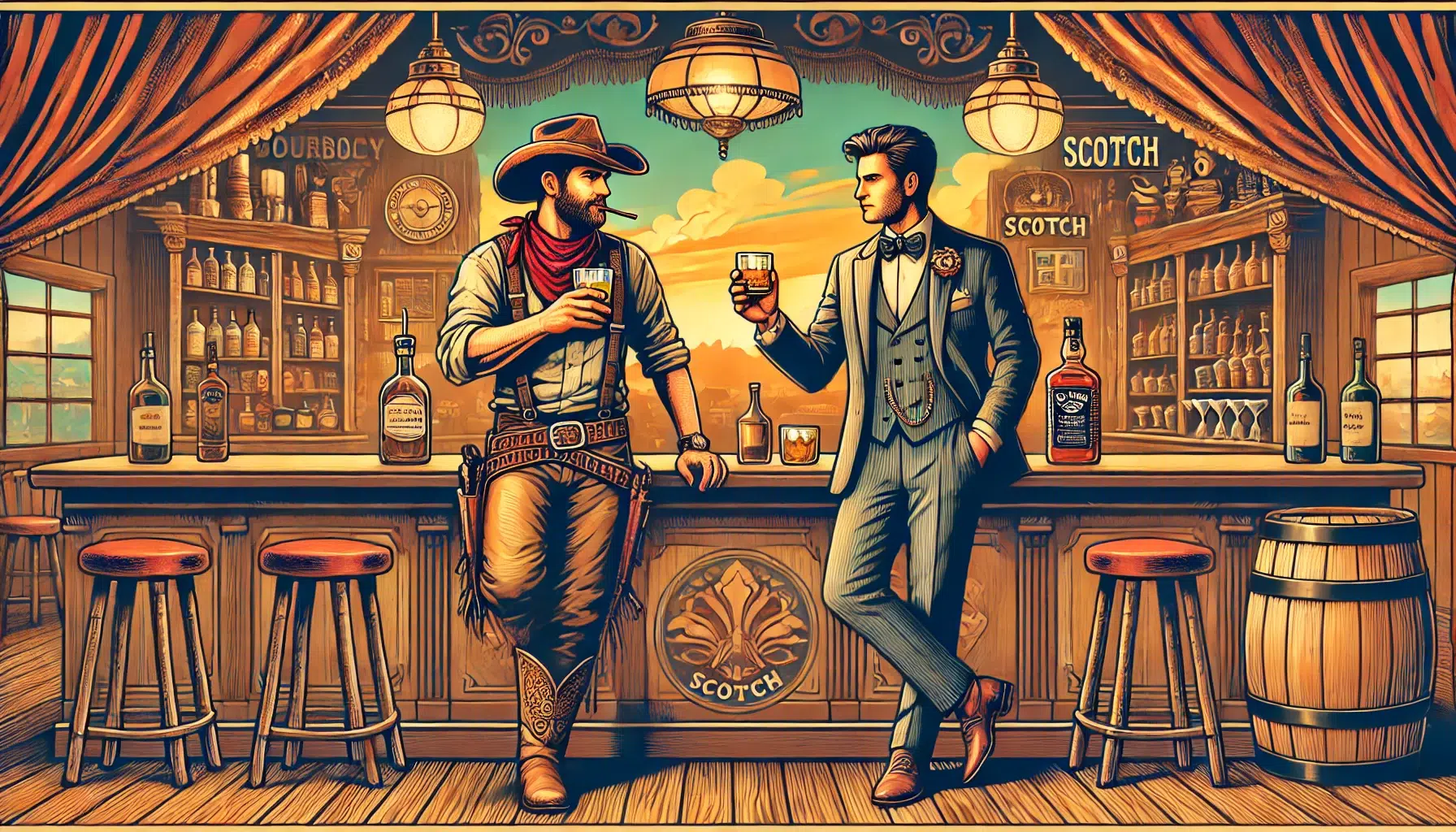Bourbon and Scotch Whisky are two whiskey heavyweights, each with its own flavor and loyal fans. Bourbon, with its American roots, is bold and sweet, thanks to its corn mash and charred oak aging. Scotch, from Scotland, offers a range of flavors from smoky and peaty to smooth and floral, shaped by barley and tradition.
While both are whiskies, they each offer a unique tasting experience. Bourbon is known for its vanilla, caramel, and oak notes, while Scotch varies by region, from Islay’s smoky to the Highlands’ floral flavors. Whether you’re into Bourbon’s American sweetness or Scotch’s diverse taste, both spirits have rich histories and distinct styles worth exploring.
The Defining Characteristics of Bourbon
Bourbon, a distinctly American spirit, is celebrated for its rich and robust profile, a result of strict production standards set forth in the United States. At its core, Bourbon must be produced in the U.S. from a grain mixture that is at least 51% corn, endowing it with its signature sweetness.

The spirit must be distilled to no more than 160 proof and entered into the barrel at 125 proof or less, ensuring a strong yet refined character. Crucially, it is aged in new, charred oak barrels, a process that imparts deep vanilla, caramel, and oak flavors, distinguishing Bourbon from other whiskies. This aging process, which has no minimum duration except for straight Bourbon, which requires at least two years, contributes to the complexity and depth of flavor that Bourbon enthusiasts cherish.
Additionally, no additives are allowed in Bourbon, ensuring that its taste and aroma remain unadulterated. These defining characteristics, from its corn dominance to its specific aging requirements, craft a spirit that is bold, sweet, and uniquely American.
The Defining Characteristics of Scotch Whisky
Scotch Whisky, a spirit deeply rooted in Scottish tradition, is renowned for its diverse and complex flavor profile, shaped by centuries of craftsmanship and the unique geography of Scotland. To be labeled as Scotch, the whisky must be made in Scotland and adhere to rigorous production criteria. It begins with malted barley, water, and yeast as its primary ingredients, with the option to include other cereal grains in blended varieties.

Scotch must be distilled to a maximum of 94.8% alcohol by volume, ensuring the retention of its distinctive flavors, and aged in oak barrels for a minimum of three years within Scotland. This aging process is crucial, as it allows the spirit to acquire a range of flavors from the wood, from peaty and smoky to smooth and sweet, depending on the region and the specific practices of the distillery. The use of peat during the malting process is a traditional method that imparts a characteristic smoky flavor to some Scotch whiskies, particularly those from Islay.
Examples of Scotch Whisky brands that showcase the diverse and complex flavor profiles include Lagavulin and Laphroaig from Islay, known for their intense peaty and smoky flavors, Glenmorangie from the Highlands, celebrated for its smooth and floral notes, and Macallan from Speyside, renowned for its rich and fruity character. These brands exemplify the influence of regional production on flavor. The classification of Scotch into categories such as single malt, blended malt, single grain, and blended grain Scotch offers a spectrum of experiences for the enthusiast, each with its own nuances and appeal.
Scotch Whisky’s adherence to tradition, combined with the natural elements of Scotland, crafts a spirit that is celebrated worldwide for its richness, depth, and variety. Reference to specific Scotch Whisky regions, like Islay, known for its peaty and smoky whiskies, Speyside, famous for its sweet and fruity flavors, and The Highlands, offering a wide range of flavors from light and floral to rich and smoky, highlights how geography influences flavor. Each region contributes uniquely to the tapestry of Scotch Whisky, making it a spirit of remarkable diversity and depth.
In What Ways Are They Similar?
Bourbon and Scotch Whisky, despite their distinct origins and production methods, share foundational similarities that unite them within the broader whiskey family. Both spirits are distilled from grain, a process that concentrates the alcohol and flavors, creating the base for their complex profiles. Aging in oak barrels is a requirement for both, albeit with different regulations, which imparts depth, color, and a wide array of flavors ranging from vanilla and caramel to woody and smoky notes.

The specific types of oak barrels used, such as American white oak for Bourbon and often European oak for Scotch, play a significant role in shaping the flavor profiles of each spirit, contributing to their distinctiveness yet shared heritage in whiskey making. This maturation process is essential to developing their distinctive characters. Additionally, Bourbon and Scotch must adhere to strict geographical indications, with Bourbon being distinctly American and Scotch exclusively Scottish, underscoring the importance of origin in defining their identities.
Furthermore, both whiskies are celebrated for their versatility in consumption, enjoyed neat, with water, or as the foundation of numerous classic and modern cocktails, making them staples in the world of spirits. Common cocktails like the Old Fashioned for Bourbon and the Scotch-based Rob Roy highlight this versatility, offering a range of experiences from the same foundational spirit.
In What Ways Are They Different?
While Bourbon and Scotch Whisky share the bond of being celebrated spirits, their differences are pronounced, rooted in geography, ingredients, and production techniques. Bourbon, hailing from the United States, primarily uses corn in its mash bill, contributing to its signature sweetness and full-bodied profile. In contrast, Scotch Whisky, produced in Scotland, often features malted barley, leading to a wide range of flavors from peaty and smoky to light and floral, influenced by the region of production.
The aging process also diverges; Bourbon is aged in new, charred oak barrels, which imparts a distinct vanilla and caramel character. The level of char in these barrels can vary, typically classified into four levels—light, medium, heavy, and alligator char—with each level influencing the intensity of the vanilla and caramel notes. Scotch, however, may be aged in used barrels, which can include those previously holding sherry, bourbon, or other spirits, introducing a broader palette of flavors.
The peat level in Scotch, particularly from regions like Islay, can significantly influence the smoky flavor, with peat being used in the malting process of the barley. Additionally, the minimum aging period differs: Bourbon has no minimum aging period for the general category, though straight Bourbon requires at least two years, whereas Scotch must be aged for at least three years. Geography plays a crucial role in the taste and production of each spirit.
For instance, the limestone-rich water of Kentucky is often credited with giving Bourbon its unique sweetness and smoothness, while the water used in Scotch production, which can vary greatly from one region to another, contributes to the distinct flavors of Scotch whiskies.
Comparing Bourbon and Scotch Whisky
Comparing Their Flavor
| Flavor Aspect | Bourbon Examples | Scotch Whisky Examples |
|---|---|---|
| Sweet Profile | Vanilla, Caramel, Oak | Peaty, Smoky, Light, Floral |
| Dominant Notes | Vanilla, Caramel, Oak | Depends on Region: Peat (Islay), Floral (Speyside) |
| Typical Flavor Profiles | Bold Sweetness, Richness | Broad Spectrum: From Smoky to Delicate |
Comparing Their Price Range
| Category | Bourbon Examples | Scotch Whisky Examples |
|---|---|---|
| Entry-Level | $20-$30 | $25-$40 |
| Mid-Range | $30-$60 | $40-$100 |
| Premium | $60+ | $100+ |
Comparing Their Distillation Process
| Process Aspect | Bourbon | Scotch Whisky |
|---|---|---|
| Distillation Type | Column Stills | Pot Stills (Mainly for Single Malt) |
| Efficiency | High (Cleaner, Sweeter Spirit) | Variable (Complexity and Flavor Depth) |
| Usage | Primarily Corn Mash | Malted Barley, Sometimes Peat Used |
Comparing Their Popularity
| Region | Bourbon | Scotch Whisky |
|---|---|---|
| United States | Widely Popular | Growing Interest |
| Europe | Growing Interest | Widely Popular |
| Asia | Increasing Interest | Strong Following |
Comparing Their Critical Acclaim
| Aspect | Bourbon | Scotch Whisky |
|---|---|---|
| Innovation | Experimental Aging, Unique Mash Bills | Tradition, Diverse Styles |
| Awards | Numerous Craft and Quality Awards | International Competitions, Recognition for Single Malts |
| Recognition | Celebrated for Craftsmanship | Celebrated for Complexity and Tradition |
This detailed comparison, utilizing markdown tables, provides a structured and exhaustive overview of the key aspects differentiating Bourbon and Scotch Whisky, including their flavor profiles, price ranges, distillation processes, popularity, and critical acclaim.
Who Is Bourbon Best For?
Bourbon is ideally suited for those who appreciate a sweet, full-bodied spirit with rich flavors of vanilla, caramel, and oak. Its versatility makes it a favorite among cocktail enthusiasts, as well as those who enjoy their whiskey neat or on the rocks. Bourbon’s wide range of profiles, from the smooth and mellow to the bold and complex, caters to both newcomers and connoisseurs alike.

Additionally, its distinctly American heritage offers a unique appeal to those interested in the rich history and tradition of American whiskey-making. Whether exploring the nuanced differences between small-batch and single-barrel offerings or delving into the craft of cocktail creation, Bourbon presents a rewarding experience for anyone seeking depth, complexity, and character in their spirits.
Bourbon Cocktails and Serving Suggestions
- Old Fashioned: A classic cocktail that showcases Bourbon’s depth, combining it with sugar, bitters, and a twist of citrus peel.
- Mint Julep: Synonymous with the Kentucky Derby, this refreshing mix of Bourbon, fresh mint, sugar, and crushed ice is perfect for warm weather.
- Bourbon Neat: Enjoying Bourbon neat, particularly a single barrel or small batch, allows one to fully appreciate the spirit’s nuanced flavors.
- Manhattan: A sophisticated cocktail that blends Bourbon with sweet vermouth and bitters, garnished with a cherry.
- Bourbon on the Rocks: A simple way to enjoy Bourbon, where a few ice cubes help to slightly mellow the spirit’s bold flavors, making it more approachable for some palates.
Who Is Scotch Whisky Best For?
Scotch Whisky appeals to those who savor the complexity and diversity of flavors that span from smoky and peaty to smooth and floral. It is a spirit that invites exploration, making it ideal for enthusiasts eager to delve into the nuanced differences between regions and distillation methods. Scotch is particularly suited for individuals who appreciate the tradition and craftsmanship inherent in whisky production, as well as the rich history of Scotland’s distilleries.

Its broad spectrum of styles, from single malts to blended scotches, offers something for every palate, whether one prefers their whisky neat, with water, or in a carefully crafted cocktail. Scotch Whisky is for those who seek not just a drink, but an experience—one that connects them to the heritage of the spirit and the land from which it comes. To enhance this experience, consider the following tasting and pairing suggestions tailored for Scotch Whisky enthusiasts:
- Tasting Events: Attend a Scotch Whisky tasting event that features a selection from different regions. This is a fantastic way to understand the distinct characteristics of whiskies from areas like Islay, Speyside, and the Highlands.
- Food Pairings: Experiment with food pairings to discover how Scotch Whisky complements various flavors. Peaty whiskies pair well with rich foods like blue cheese or dark chocolate, while lighter, floral whiskies may complement seafood or chicken dishes.
- Whisky Tours: For a deeper dive into the world of Scotch, consider a tour of Scottish distilleries. Many offer behind-the-scenes looks at the production process, from malting and distillation to aging, and provide an opportunity to taste rare and exclusive whiskies.
- Cocktail Crafting: Explore the versatility of Scotch Whisky by using it as the base for classic cocktails like the Rob Roy or the Rusty Nail. Experimenting with cocktails can reveal new dimensions of your favorite whiskies.
- Whisky Clubs: Joining a whisky club or society can provide access to exclusive tastings, limited-edition bottles, and a community of knowledgeable enthusiasts who share your passion for Scotch Whisky.





